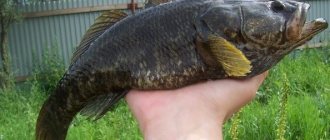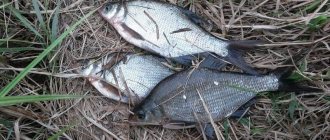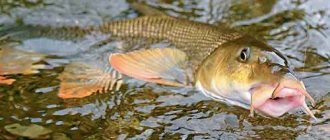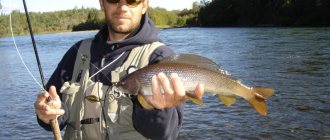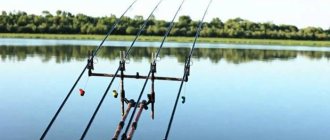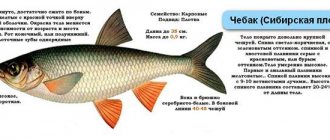Lucky were those fishermen who met such a fish as a snakehead in their lives. The snakehead is unlike any other fish; it is a unique inhabitant of reservoirs with a very impressive appearance. In fact, the snakehead looks more like a reptile than a fish, but it is still a fish, which means it can be caught like any other. Well, or almost like any other.
Catching a snakehead is still different from catching other fish, and this is not at all surprising, because such an unusual fish simply must have a special approach to fishing. This means we need to figure out how to catch a snakehead, what needs to be done for this and what to follow when catching it.
Since the snakehead is a very aggressive and strong fish, you must prepare yourself both mentally and physically to catch it. That is, you must have good gear with which you can withstand the power of the snakehead and force it to surrender after the bite. Well, now let's look at everything in order.
In this article we will look at the most effective way of catching snakeheads, in my opinion - this is catching snakeheads on a spinning rod with surface artificial baits.
Where to catch snakehead
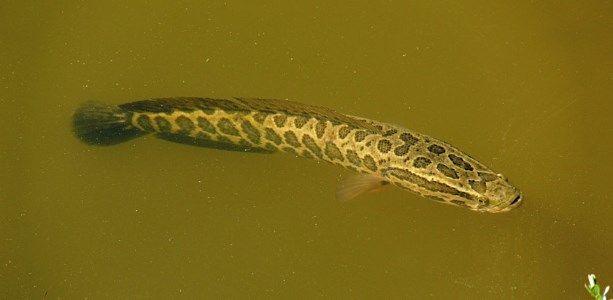
Snakeheads are mainly distributed in hot countries and warm fresh waters. Its main habitats are Africa, East and South Asia, a fairly common fish in Kazakhstan, where it was introduced artificially, but quite successfully took root and reproduced. It is inhabited in some southern water bodies of the CIS countries, including Ukraine - the Dnieper basin and the Ros River, but the snakehead does not really take root in “foreign”, not hot enough places and you need to look for it in warmer countries. As for Russia, fishermen go for snakeheads to Kazakhstan or to the border with China, to the banks of the Amur.
Snakeheads love ponds with slow water exchange that warm up well. He likes shallow areas of the reservoir, especially when the water is well warmed up; he loves overgrown backwaters and changes in depth. The first place to look for snakeheads is in weedy, shallow waters with a muddy bottom. The snakehead attacks bait floating on the surface of the water, which is why it is often called a surface predator.
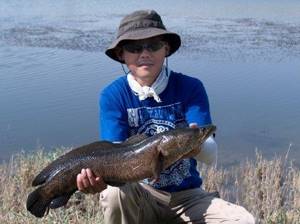
On the surface of the reservoir in which the snakehead lives, you can see how this fish grabs air from the surface and disappears again under water. The fact is that the snakehead has atmospheric respiration and breathes air, although it also has gills. Using such gulps of air, you can detect the location of the snakehead and provide bait in close proximity to the predator.
When fishing for snakeheads, you have to throw the tackle into the very thick of vegetation, and when fishing from a boat right to the shore, therefore the accuracy of the cast must be honed, otherwise an inaccurate cast will often end in a snag, wasting time and scaring away wary fish. Don’t be afraid to cast into the seaweed or under bushes in the water, because these are the places the snakehead loves. Using surface bait, which we will talk about below, you reduce the likelihood of getting caught on aquatic vegetation to almost zero, and the likelihood of a snakehead biting increases significantly.
Snakehead spawning begins around mid-summer. The female and male snakehead build themselves a nest among aquatic vegetation, which can also be seen on the surface of the water. Usually this is a patch of land cleared of vegetation with a diameter of several meters. Such an area is a very promising place for catching snakeheads, because the fish practically does not leave its home, and if it does, it is not far away. The snakehead protects its offspring - the fry and always tries to keep it in sight.
Features of catching snakehead
Just by looking at a photo of a snakehead in its natural habitat, you can immediately understand where it is best to catch it. Gear must be thrown into thickets of vegetation.
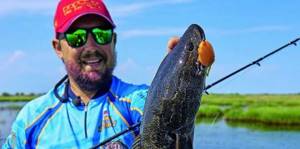
The cast must be made into the water into the thickest vegetation. It is better to use a surface bait, as it will not catch on plant stems in the water.
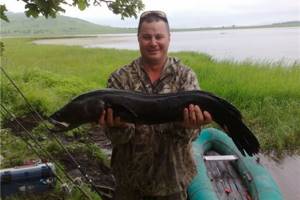
When to catch snakehead

Like any other fish, the snakehead has periods of biting and non-biting, bad periods for fishing and feeding. The fisherman must know these time periods and be sure to take them into account if he is going to the pond to catch this fish.
Snakehead fishing lasts during the warm season - from May to October. In May, snakeheads begin to become more active in the area as the water warms up. The snakehead rushes to areas of the reservoir that are well warmed by the sun, in search of warmth and food. The most active snakehead fishing takes place from lunch, about 12 noon, and lasts until 19:00. In the morning and late evening, snakeheads are also caught, but their activity decreases, along with a drop in air temperature.
Snakehead can also be caught at night, and in some reservoirs night fishing for snakehead can be very successful and this predator rushes at the bait with special inspiration.
The most favorable period for catching snakeheads is from the beginning of summer to September, and the peak of this activity occurs in the month of August. In August, the snakehead feeding season takes place and this is the best time to catch the predator. Snakehead bites become more and more greedy and furious, and their frequency goes off scale.
Snakehead dishes
Snakehead fish is famous for its white, tender meat and the absence of small bones. Before cooking, it must be cleaned of entrails and scales, and the fins, tail and head removed.
You can cook fish right on the shore of a reservoir: the carcass is salted, sprinkled with lemon juice and buried in coals or placed on a grill.
Fish stewed in tomato sauce
You will need: snakehead, fresh tomatoes (3-4 pcs.), tomatoes, a bunch of green onions, any greens (cilantro, dill), salt, ground black pepper.
How to cook:
- cut the prepared fish into small pieces, salt and pepper to taste, let stand for 20 minutes;
- scald tomatoes with boiling water, peel and cut;
- finely chop the greens;
- Heat vegetable oil in a frying pan, fry the fish on both sides until golden brown, place on a plate;
- fry the tomatoes in the same oil;
- put the fish in the resulting sauce, cover with a lid, simmer for 15 minutes.
The finished fish is transferred to a deep dish and sprinkled with a large amount of herbs on top.
Heh
The traditional Korean dish does not involve cooking the fish. It is prepared from fillet. It is enough to remove the spine: small ribs become soft during the marinating process.
Step-by-step recipe: 1.Cut the fillet into strips 2 cm thick, place in a deep bowl, and add salt. Important! You need to take 2 times more salt than during heat treatment.
2.Add 3 tablespoons of 70% vinegar essence (for fish weighing 1.5–2 kg). Mix everything, cover with a plate, put pressure on top, and put it in the refrigerator for a day.
3.Add to the bowl with fish:
- onions cut into half rings (3-4 heads);
- 5 chopped garlic cloves;
- ground red and black pepper to taste;
- finely chopped greens (dill, cilantro);
- 1 tablespoon soy sauce.
4. Mix everything, compact it, put it in the refrigerator for a day.
Sometimes additional ingredients are added to the classic heh recipe: finely chopped fresh tomatoes, cucumbers, vegetable oil.
You can cook traditional fish soup from snakehead, make cutlets and stuffing for pies.
The unusual appearance of the fish, its vitality and high taste have long been the object of close attention of fish farm managers. Snakeheads were released into water bodies in the hope of freeing the space from trash fish. The owners realized their own mistake late: the insidious predator destroyed all life around itself in a short time. It turned out to be difficult to get rid of the snakehead fish itself. Now it is bred only in isolated ponds.
Source: intellifishing.ru
What names are given to this predatory fish, whose homeland is considered to be India! Toothed and water, eel and dragon, green snake and frog... And this is not a complete list of snakehead .
And in North America it is called nothing less than fishzilla, godzilla fish or Frankenstein fish - due to its incredible gluttony and ability to move on land.
CREEPING MONSTER
The habitat of representatives of the snakehead fish is freshwater reservoirs of East Asia and tropical Africa. But even in the Amur basin you can find a representative of these unusual fish, albeit the only one.
Amur snakehead
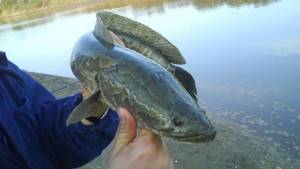
It was also brought to some fisheries in the Dnieper and Ross river basins in Ukraine. The green dragon often changes its place of residence. He can stubbornly crawl from pond to pond. Most often this happens after a food shortage occurs in the old place.
It prefers to settle in snags, very quiet reservoirs, sometimes heavily overgrown with various aquatic vegetation. He is not even afraid of the lack of oxygen, which he makes up for by floating to the surface of the water and gulping air. To do this, the fish have epibranchial organs that allow them to breathe atmospheric air.
That is, the gills provide it with 20% oxygen dissolved in water, and the epibranchial organ provides it with 80% atmospheric air. Therefore, being constantly in the water, the snakehead may die. And he can live without water for five whole days! These fish are able to survive longer periods of drought by burying themselves in wet mud.

GRUNTTING CROCODILE
It was not in vain that the snakehead got its name. Its body and head, covered with small scales on top, really resemble the outline of a snake. Of course, if such a specimen comes across unexpectedly, you can be seriously scared.
This is how a fisherman who fell asleep on a raft describes his impressions of meeting a snakehead:
“I woke up to an incomprehensibly frightened pounding of my heart. Having opened my eyes, but not yet rising or moving, I saw with horror a huge greenish-black snake head, ominously and intently staring into my face from the water from a distance of some 30 centimeters.
More than forty years have passed since that terrible moment, and as I remember now, I remember a wide flattened head in a shell of small but clearly visible scales-shields, a large cut of a predatory, yellow-edged mouth, evil, round, greenish eyes with a typically snake-like expression, widely spaced close in front. dark pupils and black stripes from them behind.
Along the powerful oval of the armored back, sharply inclined inward, stretched a long strange ridge, and it felt as if endless meters of the snake’s body were going into the water.
It seemed that in the next moment this terrible mouth would throw out a meter-long tongue, then open up, easily sweep me off the raft and send me into the womb. But as soon as I jumped up with a piercing scream, the water near the raft noisily swirled with a powerful whirlpool and the monster disappeared into the depths of the lake.”
Such a monster can be mistaken for anyone: a boa constrictor, a crocodile, a dragon. The writer Nikolai Garin-Mikhailovsky in 1898, while traveling in Korea, came to the Tumangan River bordering Russia, where he heard from local residents that supposedly in these places there was some special type of crocodiles with a short thick body, moving on four legs.
It was rumored that the heads of these creatures were similar to those of a human and that they fed on young beautiful girls. Surprisingly, a similar description was repeated in different settlements.
It is interesting that the first mention of the Tumangan crocodile is in the ancient Chinese “Catalogue of Mountains and Seas”, and this record is already 2.5 thousand years old. Another, also ancient source describes the Black River, which flows into the sea, and in it “is a Zhuan fish, similar to a frog, but with bristles. She makes a sound similar to the grunting of a pig. When they see her, there will be a great drought in the Celestial Empire.”
From these descriptions it can be assumed that the ancient grunting crocodile is the snakehead. Everything fits: the fish lives in water, but also moves on land, and makes grunting sounds when breathing.
BULL TERRIER WITH SCALES
Snakeheads are extremely voracious, they have many sharp and strong teeth and very well developed jaws. Any living creature that becomes the prey of this aggressive predator has almost no chance of salvation.
Of course, rumors that it feeds on girls are greatly exaggerated, but no one doubts that the snakehead is the top predator in the food chain of the reservoirs of Primorye. The snakehead eats everyone in the water, but no one can eat it.
It is said that its bite is equivalent in strength to the bite of a bull terrier. Hardly anyone can tell better than eyewitnesses about the hunt of this monster:
“Once I happened to see how a snakehead in shallow water grabbed a catfish half its length, but grabbed it unsuccessfully - across the body.
He killed it quickly, but swallowed it for a long time and difficultly: the catfish is a big head. He fussed, slurped, and still did not swallow it completely, but tiredly swam into the depths of his abode with his tail sticking out of his mouth.”
NIGHTMARE OF PODS
Snakeheads have no enemies in their habitat. Even when moving to a new place of residence, they cope with any predator inhabiting the reservoir, and at the same time with the rest of the inhabitants. But getting rid of them themselves can be very difficult, given their rapid reproduction, omnivorousness and extreme vitality.
Therefore, in America, for example, the authorities do their best to prevent their appearance in the lakes and rivers of the country. It is forbidden to release them not only into water bodies, but even into sewers and toilets. The snakehead is called Frankenfish there and is prohibited from being transported from state to state, as well as exported abroad.
Notices were distributed everywhere: “How to recognize a northern snakehead and what should I do if I catch one? Do not release it back, kill it and freeze it in a double bag. Notify local authorities. Leave a mark where he was caught."
In July 2002, a pond in Crofton, Maryland was drained and six adults and 100 juveniles were found. It turned out that a local resident bought fish in a supermarket and released them into the pond, for which he was fined.
The case received widespread publicity and became the subject of the film Frankenstein Fish, in which a sheriff and a biologist save a town from being eaten alive by snakehead terrorists.
Snakehead crawls on the ground and returns to the water
Today, fisheries officials, biologists and police are trying to contain the snakehead's movement toward the Great Lakes. If he gets there, then all the inhabitants of these unique reservoirs will be eaten alive.
In our country, they tried to use the snakehead as an orderly to exterminate trash fish in places where valuable species are grown. But they soon realized what a threat loomed over all living things living in these reservoirs. It is worth thinking seriously and weighing the pros and cons before deciding to resettle and breed this “beast” in our reservoirs.
MOTTO: CARE AND LOYALTY
At the age of two years, having reached a length of 30-35 centimeters, the snakehead becomes sexually mature. It spawns in the summer, since the water temperature should not be lower than 20″C, for which June and July are most optimal.
From a variety of aquatic plants, the snakehead builds its large nest, one meter in diameter, and lays eggs with fat droplets.
It is this circumstance that allows them to float and develop in the water column. The females of these fish are quite productive and can lay up to 35,000 eggs about five times in one season. After a few days, the larvae appear.
A couple of snakeheads carefully protect their offspring and nest. To ensure stable aeration of the eggs, they use their fins to create a current of water. Male snakeheads are monogamous and do not leave their female companions. And even after the fry appear, the parent snakeheads do not leave them without care and supervision, protecting and protecting their offspring in every possible way.
Alexandra ORLOVA
Source: goodnewsanimal.ru
The snakehead is a predatory fish with a distinctive appearance. The predator's mouth is large and equipped with many small teeth. The snout is short, the eyes are small and the long part of the head is covered with scales.
The body of the snakehead is cylindrical in the front part, and laterally flattened in the tail area. The color of the fish is very variegated - the belly is white, there are brown spots on the sides with black edging, there are dark stripes on the head, small dark spots are located on the bottom of the head.
Maximum length can exceed 1 m Maximum weight 10 kg
Habitat of the snakehead Under natural conditions, snakeheads are distributed on different continents of the planet - in Southeast Asia, Eastern Europe, the tropics of Africa and even in North America. In Russia, snakeheads are found in the Moscow region, Krasnodar region, Amur, and Lake Khanka. A distinctive feature from other fish is that the snakehead can breathe atmospheric air. Thanks to this, the fish are able to tolerate low oxygen levels in the water. But during the day, fish need access to the surface to breathe air.
When a reservoir dries out, a snakehead is able to burrow into the silt to a depth of more than a meter and remain there for several months until the rainy season comes and the reservoir is filled with water again. A snakehead can stay on land for up to 5 days, which allows the predator to crawl to other bodies of water.
Snakehead fishing is not a simple task, but fishing for this predator has a special appeal. The predatory, powerful fish is not so easy to catch, and therefore every fisherman will want to have such a trophy in his arsenal.
What's the best way to catch snakehead Snakehead fishing is good for those who don't like to get up early. The predator bites from lunch until the evening, which will allow you to properly prepare for fishing. Most often, anglers use rubber or PVC boats in which you can stand when fishing for snakehead. The rods chosen are strong and suitable for two hands, which makes it possible to fight powerful fish on equal terms.
It will be very difficult to land a predatory fish in a boat, which is why more often fishermen pull snakeheads ashore. That is why the reels are selected to be powerful, drum reels, with strong fishing line.
Despite its predatory and omnivorous nature, the best bait for snakeheads is a rubber frog. In order to interest the predator, the bait is pulled through the water so that it bounces. It is necessary to hook the snakehead sharply, as its mouth is hard and bony. When trying to catch these fish, be prepared for hooks to bend, lines and lines to break, and reels and rods to break.
Source: nhnch.com
What to catch snakehead with, bait
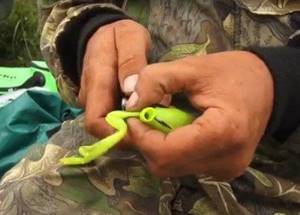
Cutting off the paws
The main method of catching snakeheads is spinning. But catching this predator is significantly different from catching other predatory fish, this applies to fishing, bait, and fishing techniques.
The following artificial baits are used to catch snakeheads:
- silicone frogs;
- rotating spoons;
- vibrotails;
- oscillating spoons;
- twisters, etc.
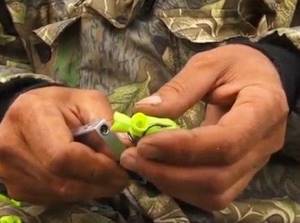
Melt with a lighter
It is very good to catch snakeheads on the bottom using live bait or pieces of fish, but anglers more often still use spinning rods to catch this fish, so we’ll talk about the best spinning baits.
The best bait option for snakeheads is a silicone frog. When retrieved, the frog walks from above along the surface of the water, creating a noise that attracts snakeheads; when the fish attacks the bait, this is clearly visible to the naked eye. The snakehead first strikes the bait several times, after which it swallows it. But you can’t rush to hook it; you need to let the snakehead swallow the bait well. In order to increase the likelihood of hooking, it is necessary to count 20-30 seconds after the snakehead hits the bait and only after that make a powerful hook. Then the probability of a snakehead leaving while fishing is practically zero.
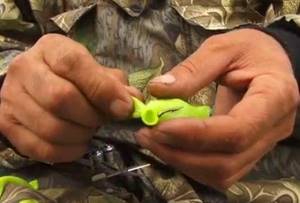
Press with fingers
As for silicone frogs for snakeheads, they also work well in store-bought versions. But some fishermen carry out simple modifications and claim that in this way the effectiveness of the bait increases significantly. What is the modification of this bait?
The legs of a silicone frog are cut off. Leaving about 1 cm from them. Since the legs are hollow, you need to melt the edges of the stumps of the legs a little with a lighter, and then squeeze them with your fingers so that they stick together, restoring the tightness of the frog. And a small hole is made in the back of the frog to allow air to escape when the snakehead bites. That's all the simple modification. Which is clearly shown in the pictures on the right.
Wiring for such a bait is very simple. After casting, it immediately begins to reel in the bait quite quickly, leading it along the surface of the water. When the snakehead strikes for the first time, it is better to reduce the speed of the retrieve so that the predator can grab the bait well.
Cook?
After all, he lives in a swamp, and eats frogs, and the meat is delicious and odorless. It doesn't look like fish at all. They even make chebureks from snakes - just add a little onion. You’ll never guess that it’s a fish: a bird, and nothing more. Good in cutlets. Hot smoked is also delicious, but minced meat is probably better! I re-read what I wrote. What a joy it is: you climb through the swamp, sometimes clinging to the grass with your hands, sometimes pushing against the hummocks with oars. You sit in the heat, there is nowhere to hide, not a tree, not a shade. Mosquitoes eat, flies bite. The legs in the boat are dirty, numb and swollen, all bitten by mosquitoes until they bleed. My hands were burned, my knees looked like boiled crayfish. Out of fifteen bites, God forbid you catch one snake, but when you catch it, you’re not happy: it’s all covered in dirt and mud. Sometimes there are not enough fishing rods for the season. Instead of sport dragging, dragging along the grass. No, there is nothing good in hunting a snake, and don’t try to persuade me! Unless... Borrow a quarter of a hundred for a ticket to Vladivostok
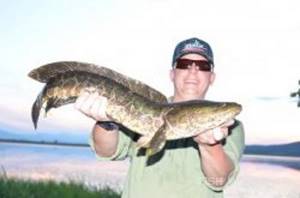
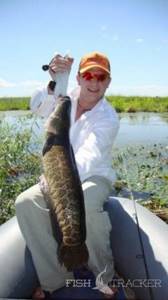
Snakehead tackle
Snakehead is a very strong fish, its bites are very powerful, as well as jerks during fishing. Therefore, it is advisable to have good, durable tackle when catching this predator. Now we will look at which tackle is best suited for catching snakeheads.
Fishing rod for snakehead . To catch snakeheads you will need a high-quality rod with a weight of 100 grams or more. Although the weight of the bait when catching this fish, of course, will be much less. Such a powerful spinning rod is needed so that the rod can withstand the load when hooking and landing fish. Basically, the snakehead hides in heavily overgrown areas of the reservoir and, after hooking, tries to hide in this grass. Often, the only way to bring a snakehead to shore is to forcefully drag it along with the vegetation. A weak spinning rod may not hold up and break even on the first snakehead.
The length of the rod should be 2.7 meters. When catching snakehead from the shore, you can use a 3.1 meter long spinning rod. With this spinning rod you can deliver bait much further than with a short rod.
Reel for catching snakehead . Ideally, use a powerful baitcasting reel that can easily cope with strong fish, even of record size. But most fishermen cannot afford such expensive gear, so if your budget does not allow you to purchase a good multiplier, take a powerful spinning reel.
Fishing line for snakehead . When fishing for snakeheads, it is best to use a soft braided line with a breaking load of at least 40 kg. You should not underestimate the power of this fish and if you are lucky enough to pull out a small snakehead on thinner tackle, you should not hope for a successful outcome when biting a large predator.
Instead of a cord, you can use monofilament fishing line, but it is advisable to use fishing line with a cross-section of at least 0.4 mm.
Snakehead hooks . To catch snakeheads with a silicone frog, spinners or wobblers, non-hook tees are used, which allow you to fish heavily overgrown areas of reservoirs and reduce the likelihood of a snag to almost zero.
Appearance, features of the respiratory system
Snakehead fish, especially at a young age, really have an external resemblance to a snake. This is clearly visible in the photo.
The fish has a flattened head with a slightly elongated snout, wide-set “snake” eyes, a large mouth and well-developed jaws. The similarity is complemented by an elongated dense body covered with greenish-brown small lamellar scales, reminiscent of snake skin in appearance.
The sides and back of the fish are decorated with dark spots with black edging, smaller spots are scattered on the white belly. There are black stripes on both sides of the head.
The length of an adult predator can reach more than a meter and weight up to 10 kg.
The legendary vitality of the snakehead fish is due to the unique structure of its respiratory system.
In addition to wide gill openings, the predator has paired epibranchial respiratory sacs. They are connected to the skin and allow the fish to breathe atmospheric air, which it vitally needs. For a breath of oxygen, the snakehead rises to the surface of the reservoir from time to time, making slurping sounds.
Another amazing ability of fish is to survive in a completely dry lake. To do this, the fish snake digs a so-called chamber with a depth of 60 cm to 1 meter in the muddy bottom, lubricates its walls with its own mucus and lies in a state of torpor until the rains fill the lake with water.
Interesting fact! In dry summers, the snake catcher often crawls from a shallow body of water to a deeper one. Migration can be tens of kilometers. An ancient Chinese legend says: “When they see the Zhuan fish, which looks like a frog covered with bristles, there will be a great drought.”
For the winter, the fish gather in small groups (up to 10 individuals) and huddle in holes under steep banks.
Interesting facts about the snakehead
- Snakeheads can breathe not only in water but also in the open air. This breathing feature allows them to migrate between bodies of water over land.
- A snakehead can live without water for up to 5 days.
- Snakeheads belong to the order Perciformes.
- The largest species of snakehead is Marulius. This snakehead is distributed from India to China and can grow over 1.2 meters in length.
- Snakehead meat is very tasty.
- Snakeheads are good parents; the nest with offspring is guarded by both the female and the male. No fish will dare to approach the snakehead’s lair.
- The snakehead has no enemies in nature (except humans).
The most fishy months
Snakeheads spawn in July. Nests are made in dense vegetation with an area of several square meters closer to the surface of the water.
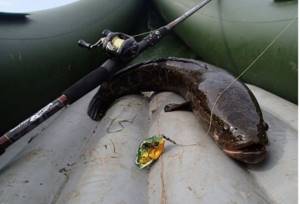
At this time, the probability of a good catch is high, since this fish does not go far from the nesting site during the spawning period.
When the fry appear, neither the female nor the male tries not to let them out of their sight. Therefore, July and August are the best time to fish for snakeheads.
Reproduction and nutrition
The snakehead is a heat-loving creature. It begins to spawn when the water warms up above 20º C (mid-June, July).
Both future parents approach the process responsibly: they build a nest with a diameter of about a meter from grass and algae. The female lays up to 35 thousand eggs in it. A special fat drop pushes the eggs to the surface, where they develop among the plants. The eggs and hatched fry are guarded by the male. Together with the female, he uses his fins to create a light whirlpool that promotes aeration of the eggs.

The male protects the offspring, so the survival rate of fry is higher than that of other fish
Juveniles feed on benthos and insect larvae. Until the fry reach 20 cm in length, the parents continue to protect them.
Adult snakehead fish are very voracious. Its diet includes all inhabitants of the reservoir: small fish, frogs, insect larvae. Can attack mice and other small animals, lizards, and waterfowl. Movable jaws with many small sharp teeth securely hold prey.
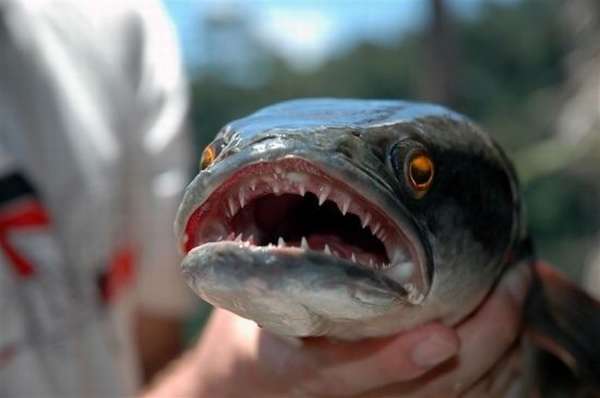
The grip of a snakehead has been compared to that of a bull terrier.
Once in a body of water, the snake-head first clears its territory, destroying its competitors. In the places where it is found, there are practically no other fish.
Interesting fact! In the USA, several years ago, a law was passed prohibiting the release of snakeheads not only into water bodies, but also into sewers. Residents are instructed to leave a warning sign on the shore if they catch fish and notify the authorities. The predator itself must be euthanized and frozen in a double bag.

